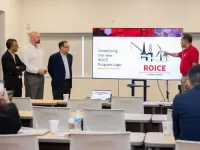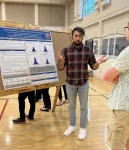(Press-News.org) The climate modeling community has been particularly vexed by the glacial/interglacial cycles of the past three million years, when the Northern Hemisphere oscillated between times with and without large ice sheets.
From about 1.25 million to 750,000 years ago—in the Pleistocene epoch—a change in glacial cycles called the Mid-Pleistocene Transition (MPT) occurred. During this time, glacial/interglacial cycles shifted from occurring every 41,000 years to every 100,000 years, with an increase in the amplitude and asymmetry of the cycles. Scientists are working to understand why these changes happened, considering that insolation forcing—variation in energy that Earth receives from the sun—does not on its own explain the change.
Now, scientists from the Mann Research Group in the School of Arts & Sciences at the University of Pennsylvania and the Potsdam Institute for Climate Impact Research have found strong path dependence, also known as hysteresis behavior, in the evolution of Plio-Pleistocene glaciations. This means the evolution of glaciations isn’t only a function of factors such as carbon dioxide levels and solar output, but also that it is constrained by previous events.
They show that a gradual decrease in both regolith—sediment that prevents the growth of large ice sheets—and in volcanic outgassing, when eruptions release carbon dioxide into the atmosphere, are required to produce the MPT. Their findings were published in Proceedings of the National Academy of Sciences.
“What we have seen in this study is that with the same amount of volcanic outgassing, the model calculates different concentrations of atmospheric CO2. This indicates that the carbon cycle does not behave linearly and depends on its initial state,” says first author Judit Carrillo, a postdoctoral fellow in the Mann Research Group.
Climate scientist Michael E. Mann says these results indicate it’s not too late to act to keep present-day ice sheets from collapsing.
The researchers explain that the model determines where the carbon dioxide that is outgassed by volcanoes goes. This could help scientists better predict the impact of human-caused greenhouse gas emissions, says Carrillo.
This research used the CLIMBER-2 Earth system model of intermediate complexity, which includes atmosphere, ocean, ice sheet, and carbon cycle components. Mann explains that this model allows researchers to do simulations of millions of years, which wouldn’t be possible with the most complex and detailed models. Matteo Willeit of the Potsdam Institute, a co-author on the paper, led a 2019 study using this model to reproduce the main features of the Plio-Pleistocene glacial/interglacial cycles.
In the new study, the researchers built on the 2019 paper by driving the model forward and backward in time over the past three million years, testing different regolith configurations to assess their impact on the MPT. The results suggest that depleted regolith and lowered CO2 levels are required to produce the 100,000-year, sawtooth-shaped cycle, but that carbon dioxide determines the onset of the MPT more fundamentally than the rate of regolith depletion.
“We find that this evolution is path dependent and, to be specific, not reversible in time,” the authors conclude. “In experiments beginning with modern preindustrial conditions and driving the model back in time with time-reversed Earth orbital and tectonic forcing, the warm, relatively ice-free conditions of the late Pliocene and early Pleistocene are not reproduced.”
Mann adds that this finding potentially has broader implications. “The fact that ice sheet extent depends not just on carbon dioxide concentrations by the direction in time, i.e. whether the climate is in a cooling or warming phase, provides a little bit of good news,” he says. “Even though ice sheet extent was greatly diminished, and sea level substantially higher the last time carbon dioxide levels were as high as they are today several million years ago, the collapse of ice sheets is probably not yet locked in. We’ve got a bit of a cushion if we can bring carbon emissions down dramatically and quickly.”
The researchers caution that because the simulations are based on a single model, and because long-term simulations of glacial/interglacial cycles are still in their infancy, their results are not a definitive characterization of climate system behavior but “should be thought of as providing evidence of dynamical behavior that is worthy of further investigation through multiple modeling frameworks.” They note that a worthwhile next step from this work would be extending simulations further back in time, into the Miocene, when carbon dioxide levels were even higher.
Carrillo says the Mann Research Group is currently working to better understand how the carbon cycle works and why hysteresis behavior occurs and is working with a new version of CLIMBER that has higher spatial resolution to better analyze the Greenland ice sheet.
Judit Carrillo is a postdoctoral researcher in the Mann Research Group in the School of Arts & Sciences at the University of Pennsylvania.
Michael E. Mann is the Presidential Distinguished Professor in the Department of Earth and Environmental Science in the School of Arts & Sciences at the University of Pennsylvania and director of the Penn Center for Science, Sustainability and the Media.
The other co-authors were Penn’s Christopher J. Larson, Shannon Christiansen, Xueke Li, and Jack G. Murphy and the Potsdam Institute for Climate Impact Research’s Matteo Willeit and Audrey Ganapolski.
This work was supported by the School of Arts & Sciences at the University of Pennsylvania and the German climate modeling project PalMod supported by the German Federal Ministry of Education and Research as a Research for Sustainability initiative (grants 01LP1920B, 01LP1917D, and 01LP2305B.)
END
Uncovering the drivers of a million-year-old glacial transition
Driving a climate model forward and backward in time, Mann Research Group scientists found strong path dependence in the evolution of Plio-Pleistocene glaciations.
2024-06-25
ELSE PRESS RELEASES FROM THIS DATE:
Surprising vortex behind new solar cell and lighting materials
2024-06-25
Metal-halide perovskites have quickly advanced in the last decade since their discovery as a semiconductor that outshines silicon in its conversion of light into electric current.
Simulations on TACC's Frontera and Lonestar6 supercomputers have revealed surprising vortex structures in quasiparticles of electrons and atoms, called polarons, which contribute to generating electricity from sunlight.
This new discovery can help scientists develop new solar cells and LED lighting. This type of lighting is hailed as eco-friendly, sustainable technology ...
Should you eat more dietary fiber? New study says it depends.
2024-06-25
ITHACA, N.Y. -- Nutritionists generally advise everyone to eat more dietary fiber, but a new Cornell University study suggests that its effects on health can vary from person to person. The findings indicate that recommendations should be tailored to each individual’s gut microbiome.
The study, published in Gut Microbes, focused on resistant starch, a category of dietary fiber found in such foods as bread, cereals, green bananas, whole-grain pasta, brown rice and potatoes.
The researchers identified ...
Researchers evaluate the benefit of dual therapy for children at risk for spinal muscular atrophy
2024-06-25
In a first-of-its-kind study, researchers compared the efficacy of preventative therapy for spinal muscular atrophy (SMA) between two well-matched study groups, using either gene therapy (onasemnogene abeparvovec) alone or in combination with risdiplam (oral medication) or nusinersen (intrathecal injection) administered before apparent signs of disease emerged. The study included presymptomatic infants with two or three copies of SMN2 at risk for developing SMA type 1 or 2, respectively. SMA is a devastating ...
Analysis suggests 2021 Texas abortion ban resulted in increase in infant deaths in state in year after law went into effect
2024-06-25
A study led by Johns Hopkins Bloomberg School of Public Health researchers estimates that infant deaths in Texas increased more than expected in the year following the state’s 2021 ban on abortion in early pregnancy, especially among infants with congenital anomalies.
The Texas law prohibiting abortions after a fetal heartbeat could be detected—as early as five or six weeks—went into effect September 1, 2021. At the time, the law—Senate Bill 8, or S.B. 8—was the most stringent state abortion law in the country. It did not allow exemptions for congenital ...
Large integrative medicine center implements processes to measure and understand clinical effectiveness
2024-06-25
CLEVELAND - Led by a team of researchers at University Hospitals Connor Whole Health, a new study finds that collecting paper-based patient-reported outcome (PRO) measures of pain, anxiety, and stress is feasible – and that provider, operational, and clinical-level factors impact successful completion more so than patient factors.
Patients often seek integrative health and medicine (IHM) modalities such as acupuncture, chiropractic, and massage in the outpatient setting, most commonly for concerns of pain, anxiety, and stress. In contrast to ...
Empathetic children may have poorer health in the face of interparental conflict
2024-06-25
UNIVERSITY PARK, Pa. — Children who report being more empathetic are more likely to show signs of poorer health in the face of more interparental conflict than less empathetic children, according to a new study led by researchers in the Penn State College of Health and Human Development.
The study, led by Hannah Schreier, associate professor of biobehavioral health and co-funded faculty member in the Social Science Research Institute, was recently published in the journal Brain, Behavior, and Immunity.
“For children this age, 7 to 9 years old, the family home and parents are important, so observing conflict ...
Marsquakes may help reveal whether liquid water exists underground on red planet
2024-06-25
UNIVERSITY PARK, Pa. — If liquid water exists today on Mars, it may be too deep underground to detect with traditional methods used on Earth. But listening to earthquakes that occur on Mars — or marsquakes — could offer a new tool in the search, according to a team led by Penn State scientists.
When quakes rumble and move through aquifers deep underground, they produce electromagnetic signals. The researchers reported in the journal JGR Planets how those signals, if also produced on Mars, could identify water miles under the surface. The study may lay the groundwork for future analyses of data from Mars missions, according to ...
Unexpected diversity of light-sensing proteins goes beyond vision in frogs
2024-06-25
UNIVERSITY PARK, Pa. — Frogs have maintained a surprising diversity of light-sensing proteins over evolutionary time, according to a new study led by a Penn State researcher. Light-sensing proteins, called opsins, enable vision in sighted animals, and are responsible for many more biological functions like regulating circadian rhythms. The researchers explored the evolution of nonvisual opsins in frogs, finding that most modern species examined in this study retained a shocking number of these proteins.
The findings were published in the June issue of the journal Molecular ...
University of Houston strengthens commitment to clean energy with key partnerships
2024-06-25
HOUSTON, June 25, 2024 - The University of Houston, the energy university with multiple energy-focused research centers, last week signed two memorandums of understanding with industry partners Promethean Energy and Endeavor Management. The agreements formalize the partnership to address the challenges of repurposing offshore infrastructure for clean energy use.
Both companies will work closely with UH Energy, the University’s interdisciplinary energy initiative, and members of UH’s Repurposing Offshore Infrastructure for Clean ...
UT Arlington prioritizes undergraduate research to ensure student success
2024-06-25
Studies have shown that undergraduate students who participate in research activities under the guidance of a faculty member or mentor are more likely to finish college. That’s one of the reasons why The University of Texas at Arlington has tripled its investment in specific undergraduate research opportunities.
“Engaging students in original scholarship is time-intensive and expensive, but the outcomes are overwhelmingly positive, leading to more student success and an increase in the number of students interested in pursuing graduate school, including medical school,” said Kayunta Johnson-Winters, interim director of undergraduate research at UTA and an associate ...
LAST 30 PRESS RELEASES:
Age-related changes in sperm DNA may play a role in autism risk
Ambitious model fails to explain near-death experiences, experts say
Multifaceted effects of inward foreign direct investment on new venture creation
Exploring mutations that spontaneously switch on a key brain cell receptor
Two-step genome editing enables the creation of full-length humanized mouse models
Pusan National University researchers develop light-activated tissue adhesive patch for rapid, watertight neurosurgical sealing
Study finds so-called super agers tend to have at least two key genetic advantages
Brain stimulation device cleared for ADHD in the US is overall safe but ineffective
Scientists discover natural ‘brake’ that could stop harmful inflammation
Tougher solid electrolyte advances long-sought lithium metal batteries
Experts provide policy roadmap to reduce dementia risk
New 3D imaging system could address limitations of MRI, CT and ultrasound
First-in-human drug trial lowers high blood fats
Decades of dredging are pushing the Dutch Western Scheldt Estuary beyond its ecological limits
A view into the innermost workings of life: First scanning electron microscope with nanomanipulator inaugurated in hesse at Goethe University
Simple method can enable early detection and prevention of chronic kidney disease
S-species-stimulated deep reconstruction of ultra-homogeneous CuS nanosheets for efficient HMF electrooxidation
Mechanical and corrosion behavior of additively manufactured NiTi shape memory alloys
New discovery rewrites the rules of antigen presentation
Researchers achieve chain-length control of fatty acid biosynthesis in yeast
Water interactions in molecular sieve catalysis: Framework evolution and reaction modulation
Shark biology breakthrough: Study tracks tiger sharks to Maui mating hub
Mysterious iron ‘bar’ discovered in famous nebula
World-first tool reduces harmful engagement with AI-generated explicit images
Learning about public consensus on climate change does little to boost people’s support for action, study shows
Sylvester Cancer Tip Sheet for January 2026
The Global Ocean Ship-Based Hydrographic Investigations Program (GO-SHIP) receives the Ocean Observing Team Award
Elva Escobar Briones selected for The Oceanography Society Mentoring Award
Why a life-threatening sedative is being prescribed more often for seniors
Findings suggest that certain medications for Type 2 diabetes reduce risk of dementia
[Press-News.org] Uncovering the drivers of a million-year-old glacial transitionDriving a climate model forward and backward in time, Mann Research Group scientists found strong path dependence in the evolution of Plio-Pleistocene glaciations.




